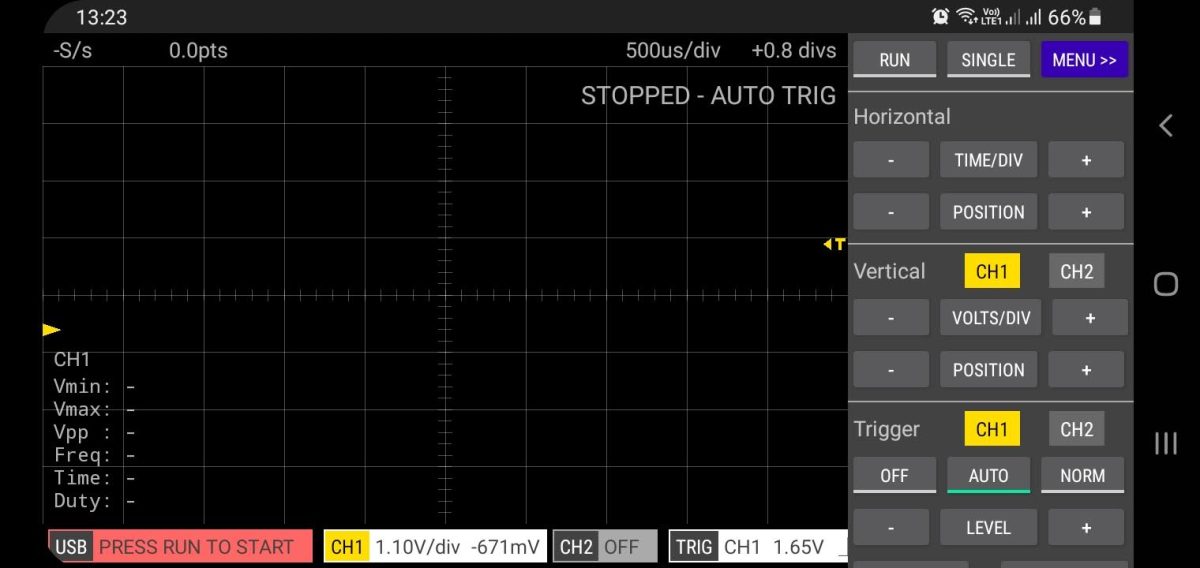Oscilloscopes and Logic analysers are essential instruments for every serious electronics hobbyist. They are however quite expensive, and thus beyond the reach of many people starting out with electronics. Today, I will show you a cheap solution, an RP2040 Oscilloscope and Logic analyser…
Before we get started, we need to clear up a few things first:
1). This is not my own project. It was designed and built by someone else.
2). This is not a professional grade Oscilloscope or Logic analyser
3). The range of input voltages, as well as the frequencies that you can measure, are limited.
What is this, and why do I bother with it?
This post is about the Scoppy Occiloscope Firmware, designed by fhdm-dev. I have no affiliation with him/her, I came across this recently and found it useful in the sense that it may help others gain access to instrumentation to greatly help them with electronics.
I did design some derived pcb components that works with this project, in order to take care of some limitations that I saw in the original project. More on that in two follow-up posts, in which I will show you two PCB’s that I designed to use with this project, and analog Frontend ( based on a public design by fhdm-dev, as well as a Logic analyser shield, of my own design
before we do this, we need to look at the basic Scoppy design and its firmware.
Getting Started
You will need a few things to make use of this project, the most important will be the Scoppy App ( available from the Google Playstore ), and an Android Phone.
You will also need a USB OTG Cable/hub for the phone, as well as a Raspberry Pi Pico or Pico W
The Installation and Getting Started Guide is very well documented, and as such, I will not spend a lot of time on that.
My own Setup
I have decided to use my own Raspberry Pi Pico Carrier board for this project, as it will allow me to get away from the breadboard, as well as serve as a platform for easily expanding on the project via expansion shields, as you will see in later articles.

This PCB, in Arduino Uno form Factor, will make putting the entire project into a case quite easy, as well as hopefully keep the number of floating hookup wires to a minimum. ( hopefully reducing some notice and other stray signals from interfering too much with our signals)
After installing the application, which is quite easy, we need to load the firmware onto the RP2040. This is also extremely easy is you follow the guide at the top.
Please note that the Android app has two modes, a freeware mode, limited to one channel, and a paid version, with no limitations. I recommend that you consider buying the paid version, as it only costs a few dollars ( I paid $USD2), and will motivate the developer to keep working on the project, and improving it.



As we can see, the interface is quite clean, and easy to use.
What are the limitations?
There are quite a few limitations, namely frequency and voltage input.
From what I can understand, the frequency limit seems to be around 25Khz, with the voltage level limit being 0.0v to 3.3v ( as per the limit of the RP2040 ADC
Please make sure that you follow all instructions on the original page, as you can very easily damage your Android device as well as the Pico if you apply a voltage outside of the allowed range.
On the logic analyser side, It is also important to note that you should stay in the 0.0v to 3.3v range of the Pico GPIO’s.
While these limited ranges will definitely limit what you can do and measure, It will still be a very useful project. In the next part of this article, I will show you how I have solved the logic analyser voltage range issue… Allowing you to analyse 5v signals as well.

